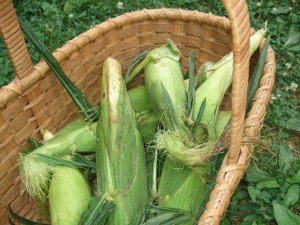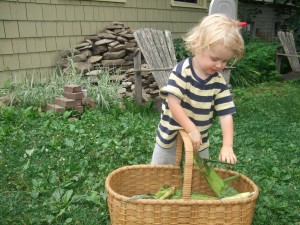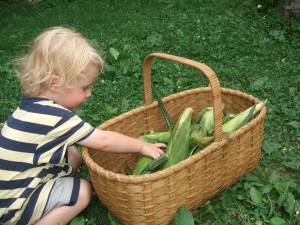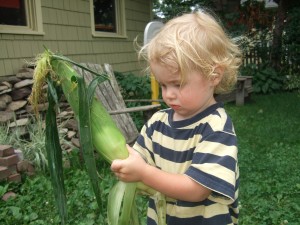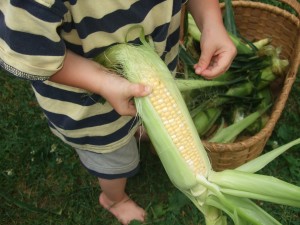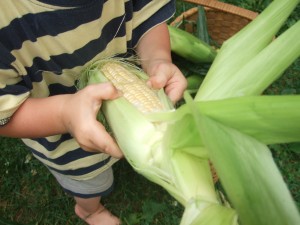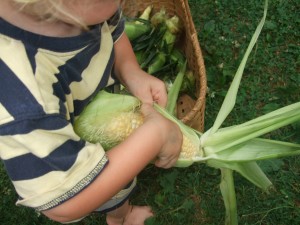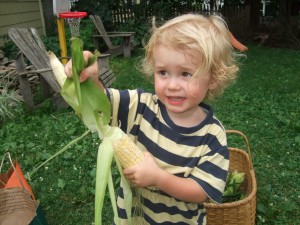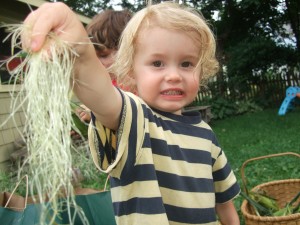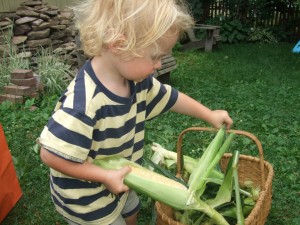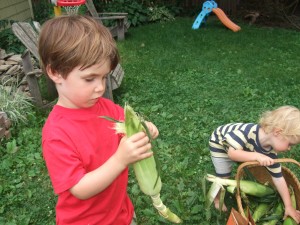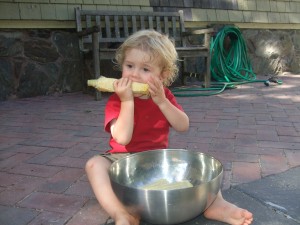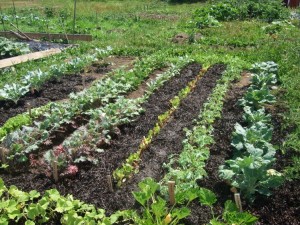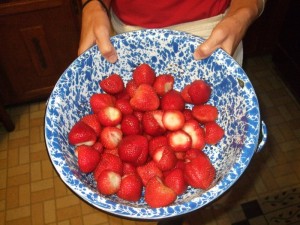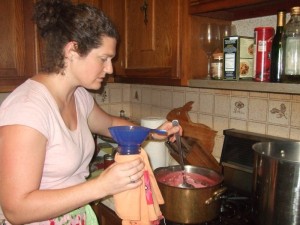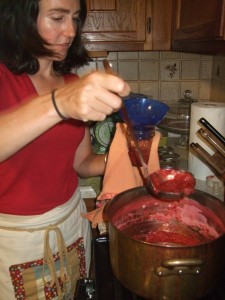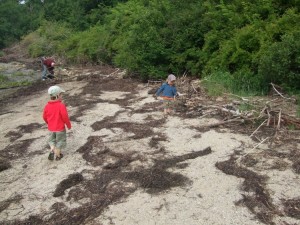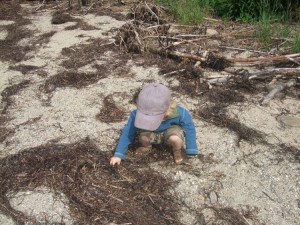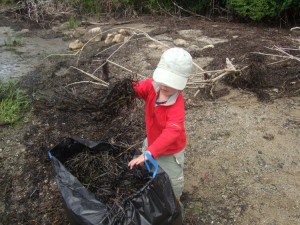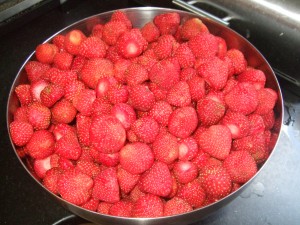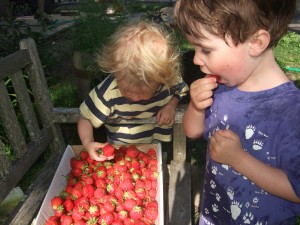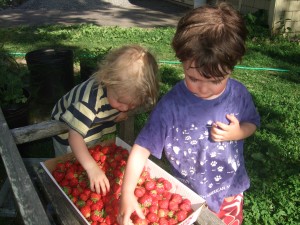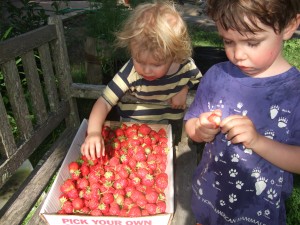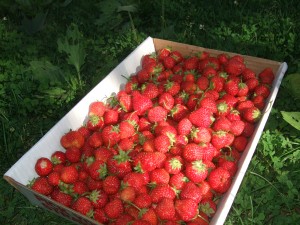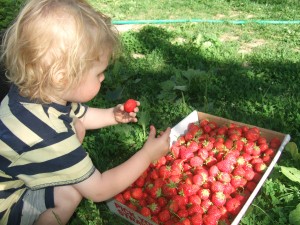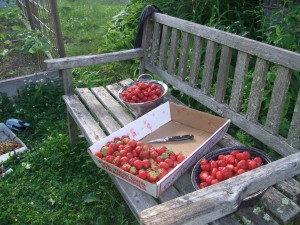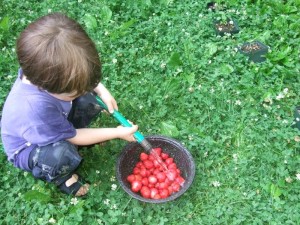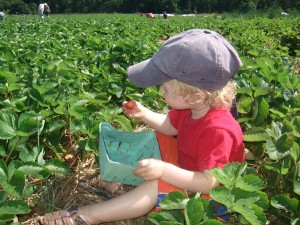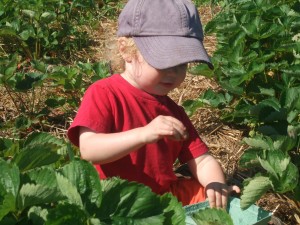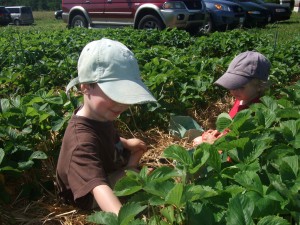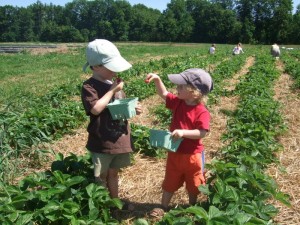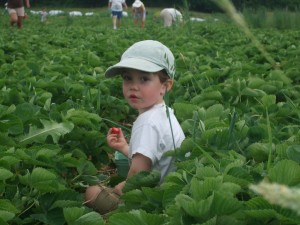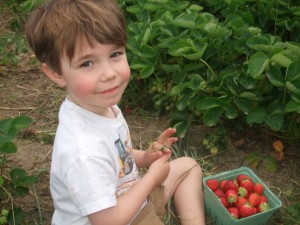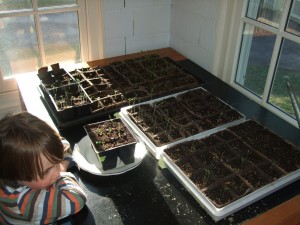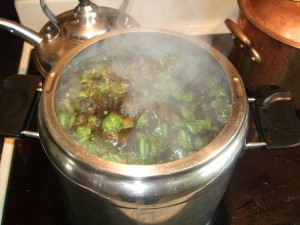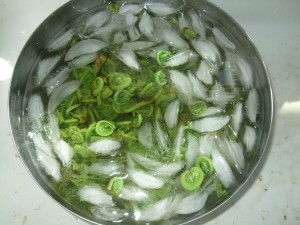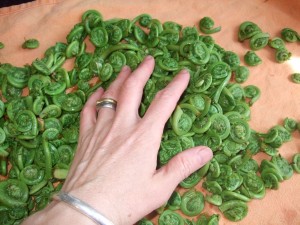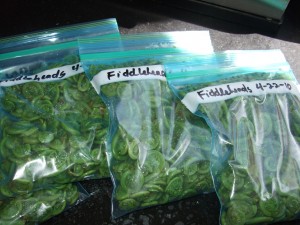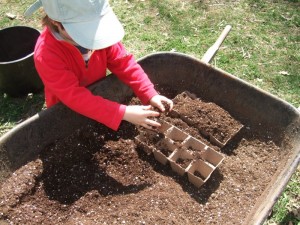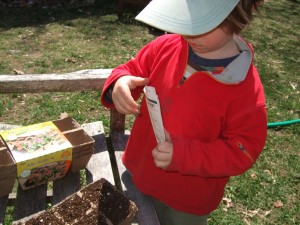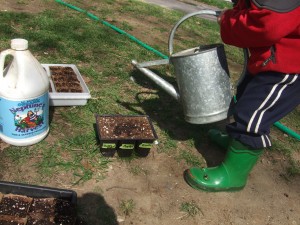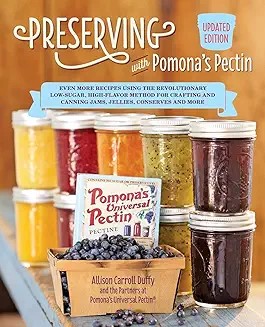Yesterday, the boys and I went corn shopping (Sounds funny, doesn’t it?). Corn is one of those things that we don’t yet grow in our own garden. Given our limited garden space, it’s one vegetable that we decided we’d have to forgo, in favor of other vegetables that seem to yield more, and can be grown more intensively in small spaces. We love corn, though, and like to fill up our freezer with a good supply of the sweet local stuff to enjoy throughout the winter. So, that means that during July and August, I’m always on the lookout for bulk deals on good, local corn. There’s a small, roadside produce market just a short trip inland that recently caught my eye while driving by, as it was advertising fresh corn at remarkably low prices. So, Connor, Ian, and I went over yesterday to check it out. When we arrived around 10:30, they were just unloading corn from the truck. Apparently the corn had come from a farm about an hour or so drive to the south, and had just been picked that morning. Yay–couldn’t ask for more than that! I bought eight dozen ears, loaded them in the back of the car, and headed home for some serious back yard shucking.
-
Corn Sweet Corn
-
Finally got the garden mulched!
Well, considering all the urgency I felt around needing to collect the eelgrass, it has taken me way too long actually get it onto the garden. I suppose it would have been relatively quick and easy to get it on there if the garden had actually been weeded already, but this was definitely NOT the case with our garden. The weeds got the best of me in June with everything else going on, so I’ve now spent the last two weeks trying to catch up. During any given weeding session, Connor likes to help for about five minutes, and Ian likes to help for about one minute, then they’re on to something else that invariably requires my attention. As you can imagine, weeding while they’re with me is a SLOW process. So, I’ve been going out as much as I can after the boys are in bed, enjoying the sunset, and then weeding by headlamp for a while more. I finally finished the weeding and mulching (the vast majority of it, anyway) yesterday–yay! Hopefully those dark, thick layers of eelgrass will keep the weeds at bay–for a while at least!
-
Strawberry Jam canning class at Ten Apple Farm
Yesterday I was back again at Ten Apple Farm, a diversified homestead in Gray run by my good friend Margaret Hathaway and her husband Karl Schatz, this time teaching a class on making and canning strawberry jam. Margaret and I had been in touch several times by phone during the couple of days prior to the class to figure out how best to handle an unexpected issue: no more local strawberries. Yes, you heard right–it was not even July 10, and strawberry season in southern Maine was officially over for the year. Broadturn farm’s organic strawberry fields had long since closed for the season, there were no strawberries to be found at our local farmer’s market, and all the nearby, conventional-pick-your-own strawberry operations had shut their doors as well. I called Rosemont Market–a small, local grocery specializing in Maine-grown foods–and they didn’t have any. Margaret even checked with farm stands quite a bit further north, hoping that it might be the tail end of the growing season there, but with no luck. When we planned the class back in March we scheduled it to occur during local strawberry season of course, and indeed I can’t ever remember berries ending so early in the summer. I tend to think of the Fourth of July as being somewhere around the height of the season, not the end of it. But this year, due to to our unusually warm winter and early spring, Strawberry season–like many other seasonal things–arrived early this year. So, what were our choices? Cancelling wasn’t a good option, and switching to blueberry or raspberry jam was risky, since it was questionable if we’d be able to find those locally yet, so early in their seasons. So, that brought us to….grocery store strawberries from California? In the end, that was our only option, and that’s what we went with. The funny thing was that for all of the stressing Margaret and I did over this issue, when I showed up on class day with six plastic boxes of berries from California, no one in the class really seemed to mind. That, or they were just being polite. While the store-boughts didn’t come close to local berries in terms of fresh-eating flavor, they were OK for jam….and they certainly looked pretty.
-
Collecting Eelgrass
Yesterday, the boys and I met my dad at the beach to collect our favorite mulch for the garden–eelgrass. Eelgrass looks like seaweed, though technically it’s a flowering plant that grows in estuaries or shallow, marshy, tidal areas along coast. It often washes up on beaches, collecting in piles around the high tide line. Like seaweed, eelgrass functions well as a mulch in terms of keeping weeds down, and is also rich with nutrients and is great for the soil as it decomposes. My stepmother is a huge gardener–flowers are her thing–and for as long as I can remember while growing up, the gardens around our house were always mulched with eelgrass. I recall her spending days at a time spreading wheelbarrow after wheelbarrow of eelgrass that she’d collected over the beds. Right now in our garden, the weeds are coming up like crazy. I really need to pull them out of there, then get some mulch on the ground to help keep them down. So yesterday that was our mission–to collect as much eelgrass for the gardens as possible. The boys and I were thrilled to see such big piles of the stuff washed up on the beach. With much help from my Dad, we stuffed handfuls of it into large trash bags and filled up the back of our car, then went back for some fun squishing around barefoot in the marshy mud. Thank you ocean for so much goodness for our garden! If you go in search of the stuff yourself, remember that it’s important only to collect eelgrass (or seaweed for that matter) that is no longer alive. Don’t pull up anything growing in the ground or attached to rocks–just take the loose stuff. And, don’t forget to put a tarp down in the back of your car—eel grass that you collect will be in various stages of decay, and can be really smelly. I can tell you from personal experience that it can take a LONG time to get the smell out of your car if it gets onto the seats. But, it’s so worth it. The gardens love it….. I have a childhood fondness for that that marshy smell anyway:-)
-
Weekend Strawberry Jam
With all the just-picked fresh strawberries in our house, jam was one of my big projects for this past weekend. After fresh-eating, jam really is one of my favorite ways to enjoy strawberries–partially, I suppose, since it allows for easy enjoyment these these local beauties year-round. The jam I made this weekend was delicious and simple to make. The recipe uses Pomona’s pectin, and is not too sweet. It also sets up a little more loosely than some other jam, which I prefer. No overly-gelatinous stuff here! All this makes it great for morning toast or peanut butter and jam sandwiches of course, but because it’s not too sweet or gelatinous, it’s equally good on top of yogurt or ice cream….or just by the spoonful!
Weekend Strawberry Jam(Makes 8-10 Half-pint jars)To do ahead of time:*Wash and rinse half-pint jars, lids, and screw bands. Set screw bands aside until ready to use. Place jars in hot water bath canner, fill at least 2/3 of the way full with water, and bring to a boil. Sterilize jars for 10 minutes, then turn down heat and let jars stand in hot water until ready to use. Place lids in water in a small pan, bring to a low simmer, and hold there until ready to use.*Prepare the calcium water (included in the Pomona’s Universal Pectin package). To do this, combine 1/2 teaspoon white calcium powder with 1/2 cup water in a small, clear container with a lid. Shake well before using. Note that you will have more calcium water than you will end up using in this recipe, and can save it for later use.Ingredients:8 cups mashed strawberries (about 3-4 quarts of whole strawberries)4 teaspoons calcium water2 ½ cups sugar4 teaspoons Pomona’s pectin powderDirections:1.) Rinse strawberries and remove stems2.) Mash strawberries in a large bowl3.) Measure mashed strawberries into a large pan4.) Add calcium water to the strawberries and mix well5.) In a separate bowl, combine sugar and pectin powder, mix well, and set aside6.) Bring strawberries to a boil, then add the sugar-pectin mixture. Stir vigorously for 1-2 minutes to dissolve the pectin.7.) Return mixture to a boil, then remove from heat.8.) Remove hot jars from canner and fill jars with jam, leaving ¼ inch of headspace. Remove trapped air bubbles, wipe rims with a damp cloth, and put on lids and screw bands.9.) Place jars back the canner, cover with lid, return to a rolling boil, and boil for 10 minutes. (Add 1 minute additional processing time for every 1000 feet above sea level.)10.) Turn off heat and allow canner and jars to sit for 5 minutes. Then, remove jars from canner.11.) Allow jars to cool undisturbed for 12-24 hours. Then, confirm that jars have sealed. Enjoy your jam! Or, store properly for later use. -
Strawberry Love
Yes indeed, strawberries are one of my all-time favorite fruits. Always have been. As a kid I loved going to Maine’s small-town strawberry festivals–falling somewhere between the last of the lupine and the Fourth of July. There I could get strawberry shortcake, or fresh-churned strawberry ice cream, and there would often be an old-timey band playing in the town bandstand. This year we didn’t make it out to any strawberry festivals, but the boys and I have been having our own little strawberry party in our back yard this year–and it’s been going on for several days. With so many trip out to Broadturn farm for picking (I’ve been–ahem–four times now) we’ve had a seemingly non-stop supply of berries to be washed and stemmed and preserved. Or rather, eaten immediately, stems and all, if Ian has his way. He adores the sourness that comes along with the sweetness of a fresh, plain berry, while Connor, on the other hand, is not so sure. He keeps trying them and wants to love them, but sometimes they’re just too sour for his liking. Friends and family are always a bit surprised to learn that he is mixed on fresh strawberries, and frankly, I am, too. (What!?! A son of mine not adoring strawberries?!?) But, one thing Connor loves to do unequivocally is to help me wash and prep the strawberries–especially when we can do it in the back yard. And, I have to say that this is by far my favorite way to do it as well–what could be better than preparing delicious, fresh berries for jam, the freezer,or dessert, snacking on them along the way, and doing it all outside on a glorious, balmy summer afternoon? Not much.
-
Strawberry Picking at Broadturn Farm
It’s strawberry season again! And it came early this year–due, I suppose, to the unseasonably warm winter and relatively early spring we’ve had. Strawberry picking is one of my favorite seasonal things to do, and so mid last week we headed out to Broadturn Farm in Scarborough. They offer organic, pick-your-own strawberries, and they’re also well known in the area for their excellent organic vegetable and flower CSAs. Broadturn is a historic farm on over 400 acres, and it has been preserved as agricultural land through the Scarborough Land Conservation Trust. Stacy Brenner and John Bliss, the farmers who’ve run the place since 2006, are great folks, and the ones responsible for growing Broadturn Farm into what it is today. Addition as of July 1, 2015: Please note that Broadturn Farm no longer offers pick-your-own strawberries…..sorry!
We had a lovely morning picking berries. It was pretty hot, but the boys didn’t seem to mind. They seemed quite content seated on the comfy straw between rows slowly picking and eating. And I was oh-so-pleasantly surprised that I actually got a decent amount in my basket! This was the first year since before Connor was born that I wasn’t trying to pick while very pregnant, or with a baby on my back, or both. And, unlike last year when we had to leave early, the boys did quite a good job this time at not stepping on, or sitting on, the strawberry plants, thankfully. Hooray for small victorties! The berries were so good, and we had such fun, that we even went back again yesterday.
-
Seedlings Growing
Earlier today I glanced into the sun porch and saw Connor there, quietly watching the seedlings. What a lovely thing to see our very active little boy being still and silently observing–even if just for a moment. I guess I’m not the only one thinking a lot about our tiny plants as they break through the soil and struggle to find the light they need to grow.
-
Freezing Fiddleheads
We went fiddlehead picking again mid last week, and finally they were up for real! We got to enjoy a couple of meals of this delicious springtime treat, and I froze the rest. Given that the season for fiddleheads is so short, I really like to preserve as many as I can to enjoy later in the year. Putting them up is easy–pickling is a traditional way to do it, and they freeze really well also. I was a bit short on time, and wanted to make sure to get them put up before they started to go downhill, so I opted for freezing this year. It’s easy and quick. Here’s how I do it:
How to Freeze Fiddleheads:
1.) Thoroughly rinse the fiddleheads in clean water. Trim the ends if necessary, and remove any loose pieces of brown, dry skin.
2.) Bring a large pot of water to a boil. Working with one small batch at a time, drop fiddleheads into boiling water. Return water to a boil and blanch fiddleheads for two minutes.
3.) Remove fiddleheads from boiling water and submerge them in ice water to cool them as quickly as possible. Rinse again with cold water and then drain them.
4.) Repeat blanching and cooling process with remaining fiddleheads.
5.) Loosely pack fiddleheads into freezer-safe containers. Label and date containers, then freeze. -
Planting the seedlings
Now that we have our potting soil ready, we can finally get our seedlings going. Yesterday was a gorgeous, sunny day, and the boys and I set ourselves up in the back yard to do some planting. I usually start some seedlings, but this year I’m planning to grow more from seed than I have other years. In particular, I’m starting our tomatoes, brussels sprouts, and broccoli from seed indoors this year, rather than buying them from the farmer’s market as I often do. (Well, that’s assuming they grow well!) We do have a sunporch where we can grow seedlings, but even this room doesn’t always get quite as much light as these little plants seem to need. But, we’re going to try. Hopefully this will be a good year.
